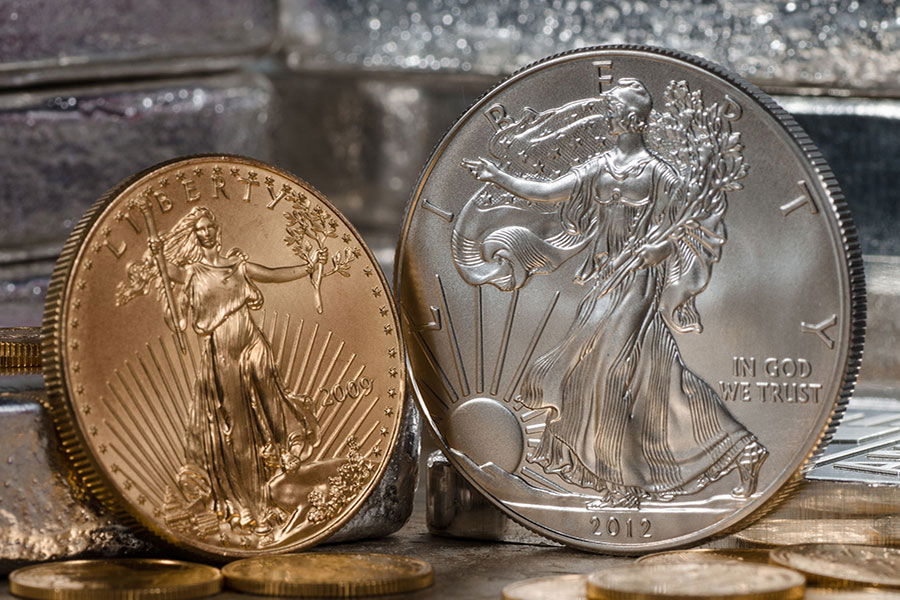Buying gold coins can be a smart way to protect your wealth, diversify your portfolio, and own a tangible asset with lasting value. Whether you’re drawn to gold bullion for its purity, collectible coins for their rarity, or semi-numismatic coins for a mix of both, knowing how to buy gold coins the right way can help you avoid costly mistakes.

In this guide, you’ll learn how to choose the best gold coins for your goals, understand premiums and pricing, spot reputable dealers, and store your coins securely. We’ll also cover how gold prices affect value, ways to avoid counterfeits, and what to expect when selling your coins so you can invest with confidence.
Key Takeaways
- Gold coins offer several investment options: bullion coins for gold content and purity, numismatic coins for rarity and design, and semi-numismatic coins for both gold value and collectible appeal.
- Successful investing requires knowing how premiums over spot price work, keeping coins liquid for resale, and selecting secure storage to protect assets.
- Smart buyers work with reputable dealers to avoid counterfeits, follow tax rules such as capital gains, and use gold coins to diversify and hedge against inflation.
Types of Gold Coins and How They Hold Value
Gold coins offer investors a physical asset with lasting worth. They come in several categories, each with its own appeal and potential for returns. Some are tied closely to the price of gold, while others gain value from their rarity or design.
From straightforward bullion coins to collectible numismatic pieces, gold coins can serve different purposes in a portfolio. They can also be a way to preserve wealth during economic uncertainty, much like silver coins and other precious metals.
Bullion Coins
Bullion coins are popular with investors who want direct exposure to gold. Their value is based on gold content and purity rather than historical or artistic qualities. Examples include the Canadian Maple Leaf and American Gold Buffalo. For those looking at larger investments, gold bars are another option.
Numismatic Coins
Numismatic coins appeal to collectors and history enthusiasts. They gain value from rarity, design, and historical ties as much as from their gold content. Because their worth depends less on daily gold prices, they can be less affected by short-term market swings.
Semi-Numismatic Coins
Semi-numismatic coins combine investment and collectible qualities. They hold intrinsic gold value but also carry premiums for rarity or unique designs. This balance makes them attractive to both long-term investors and coin collectors.
Best Gold Coins to Buy in 2025 for Investment
Choosing the right gold coin can feel overwhelming, especially with so many options available. Still, a few coins stand out for their strong market demand, high gold content, and trusted minting history. These coins are recognized worldwide, making them easier to buy, sell, and trade.
American Gold Eagle
First issued in 1986, the American Gold Eagle is one of the most widely traded bullion coins in the United States. It features Lady Liberty on the front and a family of eagles on the back, symbolizing strength and freedom.
Struck in 22-karat gold, the alloy blend of gold, copper, and silver makes the coin more resistant to scratches and wear. Investors can choose from four sizes—1 oz, 1/2 oz, 1/4 oz, and 1/10 oz—allowing flexibility in purchase amounts.
Canadian Gold Maple Leaf
Introduced in 1979, the Canadian Gold Maple Leaf is prized for its .9999 fine gold purity, one of the highest in any bullion coin. The iconic maple leaf design reflects Canada’s heritage and adds to its visual appeal.
Advanced security features, including radial lines and laser-engraved marks, make it one of the most counterfeit-resistant coins available. Its mix of purity, security, and worldwide recognition has earned it a strong reputation among both investors and collectors.
South African Krugerrand
Launched in 1967, the South African Krugerrand was the first modern gold bullion coin available to investors and remains one of the most traded coins worldwide. Struck in 22-karat gold with added copper for durability, it has a distinct reddish hue.
Featuring former president Paul Kruger on one side and a Springbok antelope on the other, it blends cultural heritage with investment appeal. Its high liquidity and long history make it a reliable choice for buyers.
Austrian Gold Philharmonic
The Austrian Gold Philharmonic, introduced in 1989, celebrates Vienna’s rich musical history with intricate depictions of instruments from the Vienna Philharmonic Orchestra. Struck in .9999 fine gold, it is one of the few bullion coins with a face value in euros, adding an extra layer of appeal for European investors. Its artistry and purity have earned it a strong reputation in global gold markets.
Factors That Impact Gold Coin Prices and Value
Buying gold coins is only the first step. The long-term value of your investment depends on factors that go beyond the coin itself. Knowing how pricing, demand, and storage affect your holdings helps you make more informed decisions.
Premiums and Spot Price
The spot price is the current market price for one troy ounce of pure gold, but most coins sell for more than that. The difference is called the premium, which covers minting costs, dealer profit, and market demand. High premiums can cut into returns, so it’s important to compare prices from multiple reputable dealers before buying.
Spot Price vs. Melt Value
Melt value is the raw worth of a coin’s gold content based on the spot price. To calculate it, multiply the coin’s pure gold weight by the current spot price. For example, if gold is $2,000 per troy ounce and a coin contains 0.5 troy ounces of pure gold, its melt value is $1,000. This baseline helps you judge whether a dealer’s price is reasonable.
Gold Weight Terms
Gold is weighed in troy ounces, which equal about 31.1 grams—slightly heavier than standard ounces. Coins may be sold in 1 oz, 1/2 oz, 1/4 oz, or 1/10 oz sizes, as well as in grams. Knowing the exact weight lets you accurately calculate value and compare coins from different mints.
Year and Mintage
The year a coin was minted and the total number produced can influence its price beyond gold content. Coins from low-mintage years or tied to notable historical events often command higher premiums. Limited editions and first-year issues can be especially desirable to collectors.
Liquidity
Gold coins are generally easy to sell worldwide, but some have stronger resale markets than others. Popular bullion coins from well-known mints typically sell faster and closer to the spot price, while lesser-known issues may take longer to find a buyer.
Storage Options
Protecting your coins is essential. Home safes offer quick access but may require extra insurance. Bank safe deposit boxes add security but limit accessibility to banking hours. Professional vaulting services provide top-tier protection and insurance, but at an ongoing cost. The right choice depends on your budget, access needs, and security priorities.
How to Buy Gold Coins Safely and Avoid Scams
Buying gold coins can be a smart investment, but you need to take clear steps to protect yourself from fraud and costly mistakes. Knowing where to purchase, how to verify authenticity, and what to inspect when your coins arrive will help ensure a safe transaction.
Choose a Reputable Dealer
Choose a reputable dealer that has a solid track record and strong customer feedback. Seek out businesses that display transparent pricing, clear policies, and membership in recognized industry organizations. The best dealers will provide full details on each coin and offer a fair return policy.
Spot Counterfeit Coins
Fake coins are a serious risk in the gold market. Reduce your chances of being scammed by purchasing only from trusted sources and requesting certificates of authenticity or independent grading. Check the coin’s weight, diameter, and design details against official mint specifications.
Inspect on Delivery
When your coins arrive, examine them immediately. Confirm that packaging is intact, the order matches your invoice, and each coin meets expected quality standards. Report any discrepancies to the dealer before finalizing the transaction.
Taxes and Legal Considerations for Gold Coin Investing
Like any investment, gold coins can involve tax obligations and legal requirements. Knowing these rules in advance helps you avoid costly mistakes.
Capital Gains Tax Rules
If you sell gold coins for more than you paid, your profit may be subject to capital gains tax. The rate depends on how long you held the coins and your overall taxable income.
Required Transaction Reporting
Some gold coin sales and purchases trigger federal reporting requirements. Stay informed about these rules and keep accurate records to ensure compliance.
Maintain Proof of Ownership
Detailed records of each purchase, including invoices and certificates, establish legal ownership and support accurate tax reporting. Store these documents securely alongside your coins.
How Gold Coins Fit into a Diversified Portfolio
Gold coins can strengthen a portfolio by adding a layer of protection that other assets may not provide. They can offset the effects of inflation, reduce exposure to market volatility, and give investors flexibility in both short- and long-term strategies.
Hedge Against Inflation
During periods of rising prices, gold coins can help preserve purchasing power. Unlike paper currency, their value often holds steady or increases when inflation erodes the worth of cash and other assets.
Balance Portfolio Risk
The value of gold coins often moves differently from stocks and bonds. When traditional markets decline, gold can help offset losses and stabilize overall returns.
Match to Investment Goals
Gold coins can suit long-term investors who want to hold a tangible asset through market cycles, as well as short-term investors looking to benefit from price swings. The right approach depends on financial goals, time horizon, and risk tolerance.
Bottom Line
Gold coins offer a unique blend of stability, flexibility, and global recognition, making them a valuable addition to many investment strategies. They can protect against inflation, balance risk, and hold value through economic shifts.
Success with gold coin investing comes from knowing the market, buying from trusted sources, and protecting your holdings. Whether you start with a single coin or build a larger collection, the key is to make each purchase with a clear plan in mind.
With careful decisions and long-term perspective, gold coins can become a reliable anchor in your portfolio while offering the satisfaction of owning a tangible, enduring asset.
Frequently Asked Questions
Can I purchase gold coins from banks?
Some banks do sell gold coins, but availability depends on the bank and the country. In many cases, banks that offer them will have a limited selection and may charge higher premiums. Most investors find better pricing and variety through established bullion dealers, coin shops, or reputable online sellers.
Is it better to invest in gold coins or gold bars?
The better choice depends on your investment goals. Gold coins offer collectability, smaller purchase sizes, and legal tender value. Gold bars usually have lower premiums over the spot price and can be more cost-effective for larger investments focused solely on gold content.
How do I sell my gold coins when I want to cash out?
You can sell gold coins to coin dealers, precious metal exchanges, online marketplaces, or auction houses. Always check the current gold price and compare offers from multiple buyers to ensure you receive a competitive payout.
What is the cheapest gold coin to buy?
Smaller bullion coins, such as 1/10 oz or 1/4 oz gold coins, typically have the lowest total cost, though their premiums over the spot price are higher compared to larger coins. For the best value per ounce, full 1 oz bullion coins from major mints often offer the lowest premium.
Do I have to pay sales tax when buying gold coins?
Sales tax on gold coins varies by location. Some states in the U.S. exempt bullion purchases from sales tax, while others tax them based on purchase amount or coin type. Check your state or country’s tax rules before buying so you can factor any additional costs into your investment.




